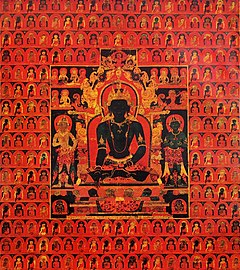Akshobhya
| Akshobya | |
|---|---|
 'The Dhyani Buddha Akshobhya', Tibetan thangka, late 13th century, Honolulu Academy of Arts. The background consists of multiple images of the Five Dhyani Buddhas. | |
| Sanskrit | Akṣobhya |
| Chinese | A Jiu Rulai |
| Japanese | Ashuku Nyorai |
| Mongolian | ᠬᠥᠳᠡᠯᠦᠰᠢ ᠦᠭᠡᠢ Хөдөлшгүй Ködelüsi ügei |
| Information | |
| Venerated by | Vajrayana |
| Attributes | Immovable One |
| Shakti | Locana |
In Vajrayana Buddhism, Akshobhya (Sanskrit for "Immovable One") (Japanese for 阿閦如来 Ashuku nyorai; Chinese 阿閦如来 āchùrúlái; Mongolian for Ködelüsi ügei) is one of the Five Wisdom Buddhas, a product of the Adibuddha, who represents consciousness as an aspect of reality. By convention he is located in the east of the Diamond Realm and is the lord of the Eastern Pure Land Abhirati ('The Joyous'), although the Pure Land of Akshobhya's western counterpart Amitabha is far better known. His consort is Mamaki and he is normally accompanied by two elephants. His color is blue and his attributes include the bell, three robes, and staff, along with a jewel, lotus, prayer wheel, and sword. He has several emanations.
Origin
Akshobhya appears in the "Scripture of the Buddha-land of Akshobhya" (阿閦佛國経 āchùfó guó jīng), which dates from 147 AD and is the oldest known Pure Land text. According to the scripture, a monk wished to practice the Dharma in the eastern world of delight and made a vow to think no anger or malice towards any being until enlightenment. He duly proved "immovable" and when he succeeded, he became the buddha Akshobhya.
Akshobhya is sometimes merged with Acala (Japanese: 不動明王 Fudō myō-ō), whose name also means 'immovable one' in Sanskrit. However, Acala is not a buddha, but one of the Five Wisdom Kings of the Womb Realm in Vajrayana.
Prior to the advent of Bhaisajyaguru (Yakushi), Akshobhya was the subject of a minor cult in Japan as a healing buddha, though even now both are found within the Shingon school of Buddhism in Japan.
Recently, newly discovered Gandhari texts from Pakistan in the Bajaur Collection have been found to contain fragments of an early Mahayan sutra mentioning Aksobhya. Preliminary dating through paleography suggests a late first century to early second century AD provenance. More conclusive radiocarbon dating is underway. A complete analysis and report of the text is expected in late 2008.
Doctrine
| Part of a series on |
| Buddhism |
|---|
 |
Iconography
Akshobhya is the embodiment of 'mirror knowledge' (Sanskrit: Ādarśa-jñāna; refer Panchajnana). A knowledge of what is real, and what is illusion, or a mere reflection of actual reality. The mirror is mind itself - clear like the sky, empty yet luminous. Holding all the images of space and time, yet untouched by them. He represents the eternal mind, and the Vajra family is connected with reason and intellect. Its brilliance illuminates the darkness of ignorance, its sharpness cuts through confusion.
The Vajra family, to which Akshobhya belongs, is associated with the element of water. This is why the two colors of Vajra are blue or white. Bright white like sun reflecting off water, and blue, like the depths of the ocean. Even if the surface of the ocean is blown into crashing waves, the depths remain undisturbed, imperturbable. And though water may seem ethereal and weightless, in truth it is extremely heavy. Water flows into the lowest place and settles there. It carves through solid rock, but calmly, without violence. When frozen, it is hard, sharp, and clear like the intellect, but to reach its full potential, it must also be fluid and adaptable like a flowing river. These are all the essential qualities of Akshobhya.
Many wrathful tantric beings are represented as blue in color because they embody the transmuted energy of hatred and aggression, into wisdom and enlightenment.
References
- Jordan, Michael, Encyclopedia of Gods, New York, Facts On File, Inc. 1993, pp. 9-10
- Vessantara, Meeting the Buddhas, Windhorse Publications 2003, chapter 9
External links
